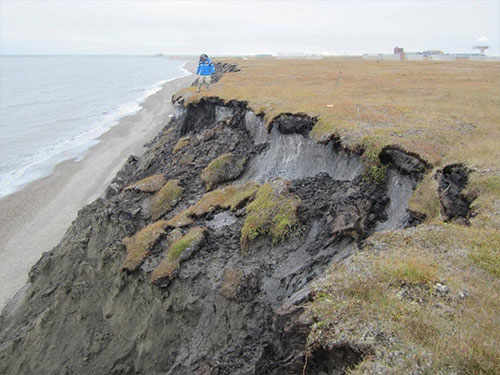
New Study Provides the First Comprehensive, Long-term Look at Alaska’s Changing Ecosystems
June 13, 2018
This is the first study to document more than three decades of land and water changes across Alaska, and it is the first study to quantify the underlying drivers of those changes, which is vital for understanding how these systems may continue to change.
Alaska has experienced glacial retreat, shrub and treeline expansion, wildfires, erosion, pollution disturbances, and other changes over the last 32 years. Most of that change occurred in boreal regions due to the residual effects of fires that are still apparent after 60 years. To fingerprint the sensitivity of Alaska’s ecosystems to changing environmental conditions and disturbances, the team of researchers combined aerial photography, satellite imagery (e.g. Landsat) and climate data into an integrated modeling framework. As a result, according to lead author Neal Pastick, the study provided the most detailed and comprehensive reconstruction of modern-day landscape transformation in Alaska to date. Renowned landscape ecologist, Professor A. David McGuire from the University of Alaska Fairbanks – and a co-lead investigator and author of a ground-breaking study in to carbon and greenhouse gas effects on Alaskan ecosystems – believes that this research "…fills a critical gap in the understanding of the historical and potential future trajectories of change not only in Alaska, but in other northern high latitude regions.” The team discovered that Arctic and boreal landscapes have experienced unprecedented changes in recent decades, a trend that is expected to continue, with significant consequences for natural and man-made systems. Despite a legacy of studies that have documented the heightened sensitivity of northern high latitude regions to change, the characterization and prognosis of that ecosystem change has remained elusive. As one example, rising air temperatures are found to have directly and indirectly promoted vegetation growth through vegetation expansion and the exposure of land surfaces as glaciers retreat. But warming has also increased evaporation, resulting in decreased plant productivity and drought that can increase the risk of disease, fire, and mortality for woody vegetation. These changes can have a substantial impact on animal migration patterns and subsistence hunting. This finding demonstrates that northern high latitudes are not responding in a simple, linear fashion as air temperatures increase. Along with increasing air temperatures, the amount of surface water has generally increased across Alaska. Surface water gains have occurred predominately in areas with extensive permafrost (perennially frozen ground) that have experienced the largest increases in mean annual air temperatures. Melting permafrost can result in land subsidence and ground collapses that affect roads, as well as other infrastructure needed for natural resource extraction. While these changes will continue to impact human and wildlife populations in Alaska, they also will influence ecosystem and climate processes which may have far-reaching consequences for communities outside of Alaska. “The upshot is that combined effects could push systems past tipping points and impact large areas, especially after fires,” said USGS scientist Bruce Wylie, who co-authored the study. Adaptation to climate change requires enhanced monitoring capabilities to detect and track changes in globally significant Arctic and boreal landscapes, and characterization and prognosis of change is an essential component for better understanding the vulnerability and resilience of northern high latitude regions to change. The continuation of the Landsat program, along with upcoming and related satellite missions (e.g. ICESat-2, Sentinel), will allow scientists to continue to fingerprint environmental and human-induced changes that affect human welfare and global ecosystems.
On the Web:
Editing by Mary Kauffman, SitNews
Source of News:
Representations of fact and opinions in comments posted are solely those of the individual posters and do not represent the opinions of Sitnews.
|
|||
